A Two-Stage Path Planning Algorithm Based on Rapid-Exploring Random Tree for Ships Navigating in Multi-Obstacle Water Areas Considering COLREGs
Abstract
:1. Introduction
2. Literature Review
2.1. Global Path Planning
2.2. Local Path Planning
2.3. RRT Algorithm
3. Methodologies
3.1. The RRT Algorithm
| Algorithm 1: RRT algorithm expand spanning tree | |
| Input: Start point Pstart; Goal point Pgoal; Set of static obstacles Osta; Distance step Dp; Samples probability Pr | |
| Output: The RRT tree Ar | |
| 1: | Create an array Ar as RRT tree and put the start point Pstart as its head node; |
| 2: | While Pgoal not in Ar |
| 3: | Generated a random number Rn between (0,1); |
| 4: | If Rn > Pr |
| 5: | Sample a sampling point Xrand in free space; |
| 6: | Else |
| 7: | Set goal point Pgoal as sampling point; |
| 8: | End If |
| 9: | Get nearest point form the sampling point Xnearest; |
| 10: | Generate new node Xnew with distance step Dp form Xnearest; |
| 11: | If no risk from Xnearest to Xnew with Osta |
| 12: | Append Xnew to Ar; |
| 13: | Else |
| 14: | Go to line 2; |
| 15: | End If |
| 16: | If distance between Xnew and Pgoal < Dp & no risk from Xnew to Pgoal with Osta |
| 17: | Append Pgoal to Ar; |
| 18: | End If |
| 19: | End While |
| 20: | Return Ar |
3.2. Global Path Planning Based on RRT Algorithm
3.2.1. Navigable Map Construction Considering Grounding Risk
3.2.2. Sampling Space and Iterative Optimization
3.2.3. Global Path Planning Algorithm Based on RRT Algorithm
| Algorithm 2: Global path planning algorithm based on RRT algorithm | |
| Input: Start point Pstart; Goal point Pgoal; Set of static obstacles Osta; Distance step Dp; Samples probability Pr; Origin path Pathrrt; Optimized path Patho; Iterative time N | |
| Output: The result of global path planning Pathg | |
| 1: | Calculate the path length of Pathrrt (Lp), Lse and Ld |
| 2: | For i = 1,2,…N do |
| 3: | Construct or update elliptic sampling space |
| 4: | Pathi generation based on RRT algorithm and ellipse sampling space |
| 5: | Sent Pathi to smooth optimization |
| 6: | Calculate the length Ls of Pathi after smooth optimization |
| 7: | If Ls < Lp |
| 8: | Assign Ls to the major axis Lp and update Ld; |
| 9: | Set Pathi as the optimized path Patho; |
| 10: | End If |
| 11: | End For |
| 12: | Return Pathg = Patho |
3.3. Local Path Planning under Dynamic Collision Risk
3.3.1. Dynamical Collision Risk Detection Based on Ship Domain
3.3.2. The Restriction of Ship Manoeuvrability and COLREGs
- 1.
- Ship manoeuvrability restriction
- 2.
- Sampling space selection considering COLREGs restriction
3.3.3. Local Path Planning Algorithm
| Algorithm 3: Local path planning algorithm under ship dynamic collision risk | |
| Input: OS position Xown; Next waypoint Xnp; static obstacles Osta; Distance step Dp; Dynamic obstacles Odyn; Samples probability Pr; Iterative time M; maximum turning angle Amax | |
| Output: Local planned path Pathl | |
| 1: | Create an array Al to store Local planned path Pathl |
| 2: | Set Xown and Xnp as the start and end point in local path planning; |
| 3: | Calculate the distance don between Xown and Xnp; |
| 4: | While Xnp not in Al |
| 5: | Constructed the elliptic sampling space, Lp = 3 * don, Lse = don; |
| 6: | Update the sampling space according to the ship encounter situation |
| 7: | Generated a random number Rn between (0, 1); |
| 8: | If Rn > Pr |
| 9: | Sample a sampling point Xrand in free space; |
| 10: | Else |
| 11: | Set goal point Xnp as sampling point; |
| 12: | End If |
| 13: | Get nearest point form the sampling point Xnearest; |
| 14: | Generate new node Xnew with distance step Dp form Xnearest; |
| 15: | Calculate the angle Anew between the Xnew and Xnearest |
| 16: | If Anew < Amax |
| 17: | If no risk from Xnearest to Xnew with Osta and Odyn //using dynamic risk detection model to judge |
| 18: | Append Xnew to Al; |
| 19: | Else |
| 20: | Go to line 7; |
| 21: | End If |
| 22: | Calculate the distance dng between Xnew and Xnp; |
| 23: | If dng < Dp & no risk from Xnew to Xnp with Osta and Odyn |
| 24: | Append Xnp to Al; |
| 25: | End If |
| 26: | Else |
| 27: | Go to line 7 |
| 28: | End If |
| 29: | End While |
| 30: | Return Pathl = Al |
4. Results and Discussion
4.1. The Experimental Situation
4.2. Result of Global Path Planning
4.3. Result of Local Path Planning
4.3.1. Overtaking Situation
4.3.2. Crossing Situation
4.3.3. Head-On Situation
4.4. Discussion and Analysis
5. Conclusions
Author Contributions
Funding
Institutional Review Board Statement
Informed Consent Statement
Data Availability Statement
Conflicts of Interest
References
- Campbell, S.; Naeem, W.; Irwin, G.W. A review on improving the autonomy of unmanned surface vehicles through intelligent collision avoidance manoeuvres. Annu. Rev. Control. 2012, 36, 267–283. [Google Scholar] [CrossRef] [Green Version]
- Perera, L.P.; Ferrari, V.; Santos, F.P.; Hinostroza, M.A.; Guedes Soares, C. Experimental Evaluations on Ship Autonomous Navigation and Collision Avoidance by Intelligent Guidance. IEEE J. Ocean. Eng. 2015, 40, 374–387. [Google Scholar] [CrossRef]
- Liu, Z.; Zhang, Y.; Yu, X.; Yuan, C. Unmanned surface vehicles: An overview of developments and challenges. Annu. Rev. Control 2016, 41, 71–93. [Google Scholar] [CrossRef]
- Hu, L.; Naeem, W.; Rajabally, E.; Watson, G.; Mills, T.; Bhuiyan, Z.; Raeburn, C.; Salter, I.; Pekcan, C. A Multiobjective Optimization Approach for COLREGs-Compliant Path Planning of Autonomous Surface Vehicles Verified on Networked Bridge Simulators. IEEE Trans. Intell. Transp. 2020, 21, 1167–1179. [Google Scholar] [CrossRef] [Green Version]
- IMO. Takes First Steps to Address Autonomous Ships. Available online: https://www.imo.org/en/MediaCentre/PressBriefings/Pages/08-MSC-99-MASS-scoping.aspx (accessed on 25 May 2018).
- IMO. Outcome of the Regulatory Scoping Exercise for the Use of Maritime Autonomous Surface Ships (MASS); IMO: London, UK, 2021. [Google Scholar]
- EMSA. Annual Overview of Marine Casualties and Incidents 2020; ESMA: Lisbon, Portugal, 2020. [Google Scholar]
- Guedes Soares, C.; Teixeira, A.P. Risk assessment in maritime transportation. Reliab. Eng. Syst. Saf. 2001, 74, 299–309. [Google Scholar] [CrossRef]
- Antão, P.; Guedes Soares, C. Causal factors in accidents of high-speed craft and conventional ocean-going vessels. Reliab. Eng. Syst. Saf. 2008, 93, 1292–1304. [Google Scholar] [CrossRef]
- Zhang, G.; Thai, V.V. Expert elicitation and Bayesian Network modeling for shipping accidents: A literature review. Saf. Sci. 2016, 87, 53–62. [Google Scholar] [CrossRef]
- Fan, S.; Blanco-Davis, E.; Yang, Z.; Zhang, J.; Yan, X. Incorporation of human factors into maritime accident analysis using a data-driven Bayesian network. Reliab. Eng. Syst. Saf. 2020, 203, 107070. [Google Scholar] [CrossRef]
- Graziano, A.; Teixeira, A.P.; Guedes Soares, C. Classification of human errors in grounding and collision accidents using the TRACEr taxonomy. Saf. Sci. 2016, 86, 245–257. [Google Scholar] [CrossRef]
- Sotiralis, P.; Ventikos, N.P.; Hamann, R.; Golyshev, P.; Teixeira, A.P. Incorporation of human factors into ship collision risk models focusing on human centred design aspects. Reliab. Eng. Syst. Saf. 2016, 156, 210–227. [Google Scholar] [CrossRef]
- Wu, B.; Yip, T.L.; Yan, X.; Guedes Soares, C. Review of techniques and challenges of human and organizational factors analysis in maritime transportation. Reliab. Eng. Syst. Saf. 2022, 219, 108249. [Google Scholar] [CrossRef]
- Tsou, M.; Kao, S.; Su, C. Decision Support from Genetic Algorithms for Ship Collision Avoidance Route Planning and Alerts. J. Navig. 2010, 63, 167–182. [Google Scholar] [CrossRef]
- Perera, L.P.; Carvalho, J.P.; Guedes Soares, C. Fuzzy logic based decision making system for collision avoidance of ocean navigation under critical collision conditions. J. Mar. Sci. Technol. 2011, 16, 84–99. [Google Scholar] [CrossRef]
- Perera, L.P.; Carvalho, J.P.; Guedes Soares, C. Intelligent Ocean Navigation and Fuzzy-Bayesian Decision/Action Formulation. IEEE J. Ocean. Eng. 2012, 37, 204–219. [Google Scholar] [CrossRef]
- Zhang, J.; Zhang, D.; Yan, X.; Haugen, S.; Guedes Soares, C. A distributed anti-collision decision support formulation in multi-ship encounter situations under COLREGs. Ocean Eng. 2015, 105, 336–348. [Google Scholar] [CrossRef]
- Xie, L.; Xue, S.; Zhang, J.; Zhang, M.; Tian, W.; Haugen, S. A path planning approach based on multi-direction A algorithm for ships navigating within wind farm waters. Ocean Eng. 2019, 184, 311–322. [Google Scholar] [CrossRef]
- Huang, Y.; Chen, L.; Chen, P.; Negenborn, R.R.; van Gelder, P.H.A.J. Ship collision avoidance methods: State-of-the-art. Saf. Sci. 2020, 121, 451–473. [Google Scholar] [CrossRef]
- Han, S.; Wang, L.; Wang, Y.; He, H. An efficient motion planning based on grid map: Predicted Trajectory Approach with global path guiding. Ocean Eng. 2021, 238, 109696. [Google Scholar] [CrossRef]
- Thombre, S.; Zhao, Z.; Ramm-Schmidt, H.; Garcia, J.M.V.; Malkamaki, T.; Nikolskiy, S.; Hammarberg, T.; Nuortie, H.; Bhuiyan, M.Z.H.; Sarkka, S.; et al. Sensors and AI Techniques for Situational Awareness in Autonomous Ships: A Review. IEEE Trans. Intell. Transp. 2022, 23, 64–83. [Google Scholar] [CrossRef]
- Han, S.; Wang, L.; Wang, Y. A COLREGs-compliant guidance strategy for an underactuated unmanned surface vehicle combining potential field with grid map. Ocean Eng. 2022, 255, 111355. [Google Scholar] [CrossRef]
- IMO. International Convention on Standards of Training, Certification and Watchkeeping for Seafarers 1978. Commonw. Law Bull. 1984, 10, 1312. [Google Scholar]
- Kim, H.; Kim, D.; Shin, J.; Kim, H.; Myung, H. Angular rate-constrained path planning algorithm for unmanned surface vehicles. Ocean Eng. 2014, 84, 37–44. [Google Scholar] [CrossRef]
- Kim, H.; Kim, D.; Kim, H.; Shin, J.; Myung, H. An extended any-angle path planning algorithm for maintaining formation of multi-agent jellyfish elimination robot system. Int. J. Control. Autom. Syst. 2016, 14, 598–607. [Google Scholar] [CrossRef]
- Zhang, M.; Zhang, D.; Fu, S.; Kujala, P.; Hirdaris, S. A predictive analytics method for maritime traffic flow complexity estimation in inland waterways. Reliab. Eng. Syst. Safe. 2022, 220, 108317. [Google Scholar] [CrossRef]
- Claussmann, L.; Revilloud, M.; Gruyer, D.; Glaser, S. A Review of Motion Planning for Highway Autonomous Driving. IEEE Trans. Intell. Transp. 2020, 21, 1826–1848. [Google Scholar] [CrossRef] [Green Version]
- Wang, N.; Xu, H. Dynamics-Constrained Global-Local Hybrid Path Planning of an Autonomous Surface Vehicle. IEEE Trans. Veh. Technol. 2020, 69, 6928–6942. [Google Scholar] [CrossRef]
- Lazarowska, A. A new deterministic approach in a decision support system for ship’s trajectory planning. Expert Syst. Appl. 2017, 71, 469–478. [Google Scholar] [CrossRef]
- Wang, N.; Su, S. Finite-Time Unknown Observer-Based Interactive Trajectory Tracking Control of Asymmetric Underactuated Surface Vehicles. IEEE Trans. Control Syst. Technol. 2021, 29, 794–803. [Google Scholar] [CrossRef]
- Hinostroza, M.A.; Xu, H.; Guedes Soares, C. Motion Planning, Guidance, and Control System for Autonomous Surface Vessel. J. Offshore Mech. Arct. Eng. 2021, 143, 041202. [Google Scholar] [CrossRef]
- Wu, G.; Atilla, I.; Tahsin, T.; Terziev, M.; Wang, L. Long-voyage route planning method based on multi-scale visibility graph for autonomous ships. Ocean Eng. 2021, 219, 108242. [Google Scholar] [CrossRef]
- Vettor, R.; Guedes Soares, C. Development of a ship weather routing system. Ocean Eng. 2016, 123, 1–14. [Google Scholar] [CrossRef]
- Namgung, H. Local Route Planning for Collision Avoidance of Maritime Autonomous Surface Ships in Compliance with COLREGs Rules. Sustainability 2021, 14, 198. [Google Scholar] [CrossRef]
- Lau, B.; Sprunk, C.; Burgard, W. Efficient grid-based spatial representations for robot navigation in dynamic environments. Robot. Auton. Syst. 2013, 61, 1116–1130. [Google Scholar] [CrossRef]
- Yang, S.; Meng, M. An efficient neural network approach to dynamic robot motion planning. Neural Netw. 2000, 13, 143–148. [Google Scholar] [CrossRef]
- Tam, C.; Bucknall, R. Path-planning algorithm for ships in close-range encounters. J. Mar. Sci. Technol. 2010, 15, 395–407. [Google Scholar] [CrossRef]
- Perera, L.P.; Carvalho, J.P.; Guedes Soares, C. Solutions to the Failures and Limitations of Mamdani Fuzzy Inference in Ship Navigation. IEEE Trans. Veh. Technol. 2014, 63, 1539–1554. [Google Scholar] [CrossRef]
- Zhang, M.; Zhang, D.; Goerlandt, F.; Yan, X.; Kujala, P. Use of HFACS and fault tree model for collision risk factors analysis of icebreaker assistance in ice-covered waters. Saf. Sci. 2019, 111, 128–143. [Google Scholar] [CrossRef]
- Zhang, M.; Montewka, J.; Manderbacka, T.; Kujala, P.; Hirdaris, S. A Big Data Analytics Method for the Evaluation of Ship—Ship Collision Risk reflecting Hydrometeorological Conditions. Reliab. Eng. Syst. Saf. 2021, 213, 107674. [Google Scholar] [CrossRef]
- Liu, J.; Zhang, J.; Yan, X.; Guedes Soares, C. Multi-ship collision avoidance decision-making and coordination mechanism in Mixed Navigation Scenarios. Ocean Eng. 2022, 257, 111666. [Google Scholar] [CrossRef]
- Cai, M.; Zhang, J.; Zhang, D.; Yuan, X.; Guedes Soares, C. Collision risk analysis on ferry ships in Jiangsu Section of the Yangtze River based on AIS data. Reliab. Eng. Syst. Saf. 2021, 215, 107901. [Google Scholar] [CrossRef]
- Chen, P.; Huang, Y.; Mou, J.; van Gelder, P.H.A.J. Ship collision candidate detection method: A velocity obstacle approach. Ocean Eng. 2018, 170, 186–198. [Google Scholar] [CrossRef]
- Xin, X.; Liu, K.; Yang, X.; Yuan, Z.; Zhang, J. A simulation model for ship navigation in the “Xiazhimen” waterway based on statistical analysis of AIS data. Ocean Eng. 2019, 180, 279–289. [Google Scholar] [CrossRef]
- Hu, Y.; Zhang, A.; Tian, W.; Zhang, J.; Hou, Z. Multi-Ship Collision Avoidance Decision-Making Based on Collision Risk Index. J. Mar. Sci. Eng. 2020, 8, 640. [Google Scholar] [CrossRef]
- Yuan, X.; Zhang, D.; Zhang, J.; Zhang, M.; Guedes Soares, C. A novel real-time collision risk awareness method based on velocity obstacle considering uncertainties in ship dynamics. Ocean Eng. 2021, 220, 108436. [Google Scholar] [CrossRef]
- Lyu, H.; Yin, Y. COLREGS-Constrained Real-time Path Planning for Autonomous Ships Using Modified Artificial Potential Fields. J. Navig. 2019, 72, 588–608. [Google Scholar] [CrossRef]
- Niu, H.; Lu, Y.; Savvaris, A.; Tsourdos, A. An energy-efficient path planning algorithm for unmanned surface vehicles. Ocean Eng. 2018, 161, 308–321. [Google Scholar] [CrossRef] [Green Version]
- Silveira, P.; Teixeira, Â.P.; Guedes Soares, C. AIS Based Shipping Routes Using the Dijkstra Algorithm. TransNav 2019, 13, 565–571. [Google Scholar] [CrossRef]
- Wang, H.; Guo, F.; Yao, H.; He, S.; Xu, X. Collision Avoidance Planning Method of USV Based on Improved Ant Colony Optimization Algorithm. IEEE Access 2019, 7, 52964–52975. [Google Scholar] [CrossRef]
- Fiskin, R.; Atik, O.; Kisi, H.; Nasibov, E.; Johansen, T.A. Fuzzy domain and meta-heuristic algorithm-based collision avoidance control for ships: Experimental validation in virtual and real environment. Ocean Eng. 2021, 220, 108502. [Google Scholar] [CrossRef]
- Wang, S.; Yan, X.; Ma, F.; Wu, P.; Liu, Y. A novel path following approach for autonomous ships based on fast marching method and deep reinforcement learning. Ocean Eng. 2022, 257, 111495. [Google Scholar] [CrossRef]
- Wang, W.; Deng, H.; Wu, X. Path planning of loaded pin-jointed bar mechanisms using Rapidly-exploring Random Tree method. Comput. Struct. 2018, 209, 65–73. [Google Scholar] [CrossRef]
- Enevoldsen, T.T.; Galeazzi, R. Grounding-aware RRT⁎ for Path Planning and Safe Navigation of Marine Crafts in Confined Waters. IFAC-PapersOnLine 2021, 54, 195–201. [Google Scholar] [CrossRef]
- Li, Y.; Wei, W.; Gao, Y.; Wang, D.; Fan, Z. PQ-RRT: An improved path planning algorithm for mobile robots. Expert Syst. Appl. 2020, 152, 113425. [Google Scholar] [CrossRef]
- Chiang, H.L.; Tapia, L. COLREG-RRT: An RRT-Based COLREGS-Compliant Motion Planner for Surface Vehicle Navigation. IEEE Robot. Autom. Lett. 2018, 3, 2024–2031. [Google Scholar] [CrossRef]
- Enevoldsen, T.T.; Reinartz, C.; Galeazzi, R. COLREGs-Informed RRT* for Collision Avoidance of Marine Crafts. In Proceedings of the 2021 IEEE International Conference on Robotics and Automation (ICRA), Xi’an, China, 30 May–5 June 2021; pp. 8083–8089. [Google Scholar]
- Ning, W. A Novel Analytical Framework for Dynamic Quaternion Ship Domains. J. Navig. 2013, 66, 265–281. [Google Scholar]
- Silveira, P.; Teixeira, A.P.; Guedes Soares, C. A method to extract the Quaternion Ship Domain parameters from AIS data. Ocean Eng. 2022, 257, 111568. [Google Scholar] [CrossRef]
- Lonklang, A.; Botzheim, J. Improved Rapidly Exploring Random Tree with Bacterial Mutation and Node Deletion for Offline Path Planning of Mobile Robot. Electronics 2022, 11, 1459. [Google Scholar] [CrossRef]
- Wang, X.; Wei, J.; Zhou, X.; Xia, Z.; Gu, X. AEB-RRT: An adaptive extension bidirectional RRT algorithm. Auton. Robot. 2022, 46, 685–704. [Google Scholar] [CrossRef]
- Sintov, A.; Borum, A.; Bretl, T. Motion Planning of Fully Actuated Closed Kinematic Chains with Revolute Joints: A Comparative Analysis. IEEE Robot. Autom. Lett. 2018, 3, 2886–2893. [Google Scholar] [CrossRef]
- Zhang, M.; Kujala, P.; Hirdaris, S. A machine learning method for the evaluation of ship grounding risk in real operational conditions. Reliab. Eng. Syst. Saf. 2022, 226, 108697. [Google Scholar] [CrossRef]
- Wei, K.; Ren, B. A Method on Dynamic Path Planning for Robotic Manipulator Autonomous Obstacle Avoidance Based on an Improved RRT Algorithm. Sensors 2018, 18, 571. [Google Scholar] [CrossRef] [PubMed] [Green Version]
- Abaei, M.M.; Arzaghi, E.; Abbassi, R.; Garaniya, V.; Javanmardi, M.; Chai, S. Dynamic reliability assessment of ship grounding using Bayesian Inference. Ocean Eng. 2018, 159, 47–55. [Google Scholar] [CrossRef]
- Mate, B.; Robert, M.; Djani, M. Determining Restricted Fairway Additional Width due to Bank Effect for Fine Form Vessels. J. Navig. 2019, 72, 1435–1448. [Google Scholar]
- Li, J.; Li, C.; Chen, T.; Zhang, Y. Improved RRT Algorithm for AUV Target Search in Unknown 3D Environment. J. Mar. Sci. Eng. 2022, 10, 826. [Google Scholar] [CrossRef]
- Zhang, M.; Conti, F.; Le Sourne, H.; Vassalos, D.; Kujala, P.; Lindroth, D.; Hirdaris, S. A method for the direct assessment of ship collision damage and flooding risk in real conditions. Ocean Eng. 2021, 237, 109605. [Google Scholar] [CrossRef]
- Zhou, K.; Chen, J.; Liu, X. Optimal Collision-Avoidance Manoeuvres to Minimise Bunker Consumption under the Two-Ship Crossing Situation. J. Navig. 2018, 71, 151–168. [Google Scholar] [CrossRef]
- He, Y.; Jin, Y.; Huang, L.; Xiong, Y.; Chen, P.; Mou, J. Quantitative analysis of COLREG rules and seamanship for autonomous collision avoidance at open sea. Ocean Eng. 2017, 140, 281–291. [Google Scholar] [CrossRef]
- Gia, H.D.; Nam-kyun, I. The combination of analytical and statistical method to define polygonal ship domain and reflect human experiences in estimating dangerous area. Int. J. e-Navig. Marit. Econ. 2016, 4, 97–108. [Google Scholar]
- Zhang, L.; Meng, Q. Probabilistic ship domain with applications to ship collision risk assessment. Ocean Eng. 2019, 186, 106130. [Google Scholar] [CrossRef]
- Liu, K.; Yuan, Z.; Xin, X.; Zhang, J.; Wang, W. Conflict detection method based on dynamic ship domain model for visualization of collision risk Hot-Spots. Ocean Eng. 2021, 242, 110143. [Google Scholar] [CrossRef]
- Wang, X.; Liu, Z.; Cai, Y. The ship maneuverability based collision avoidance dynamic support system in close-quarters situation. Ocean Eng. 2017, 146, 486–497. [Google Scholar] [CrossRef]
- Xu, H.; Rong, H.; Guedes Soares, C. Use of AIS data for guidance and control of path-following autonomous vessels. Ocean Eng. 2019, 194, 106635. [Google Scholar] [CrossRef]
- Wang, T.; Wu, Q.; Zhang, J.; Wu, B.; Wang, Y. Autonomous decision-making scheme for multi-ship collision avoidance with iterative observation and inference. Ocean Eng. 2020, 197, 106873. [Google Scholar] [CrossRef]
- Cockcroft, A.N.; Lameijer, J.N.F. A Guide to the Collision Avoidance Rules: International Regulations for Preventing Collisions at Sea, 7th ed.; Butterworth-Heinemann: Oxford, UK, 2012. [Google Scholar]

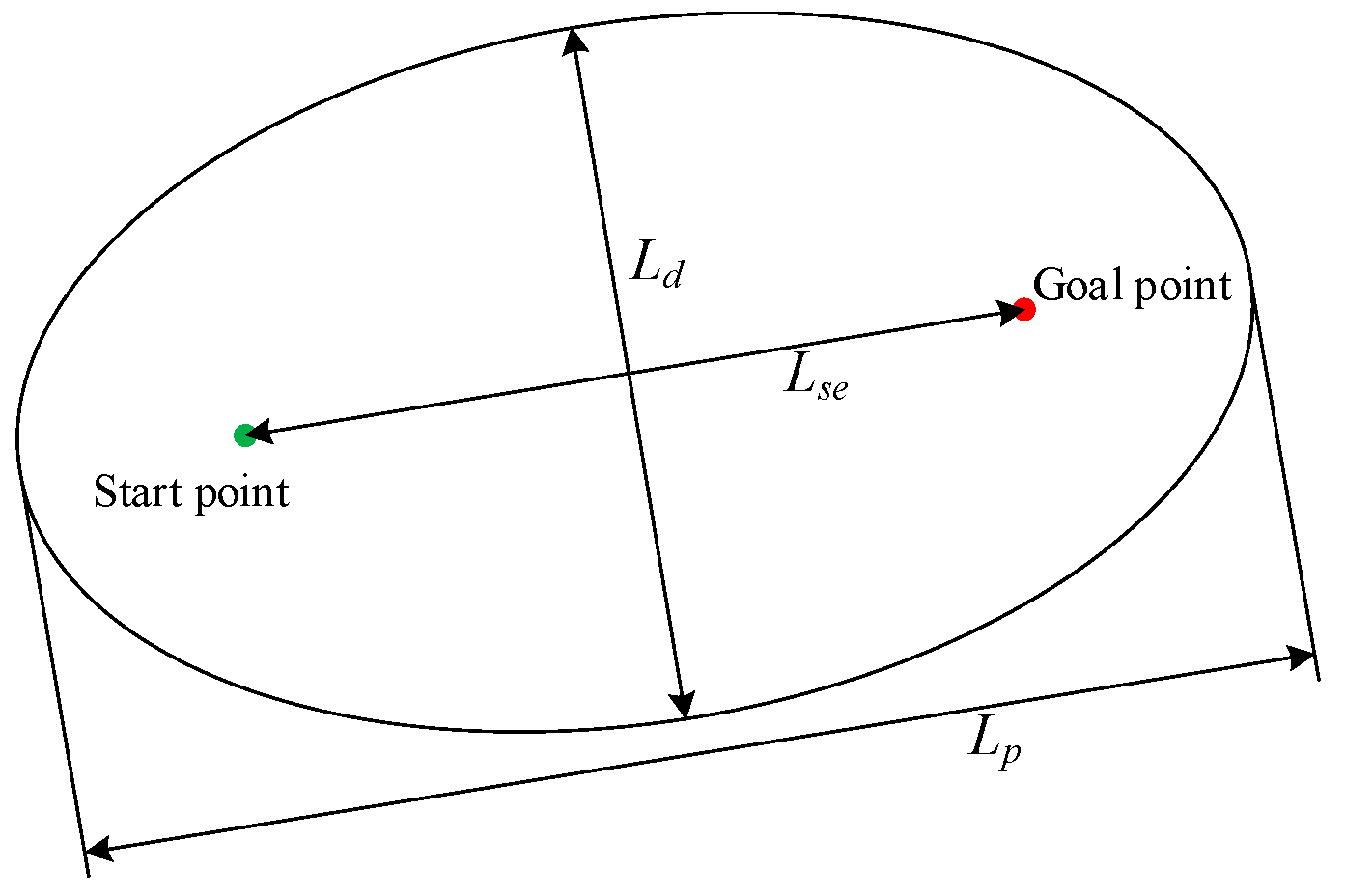
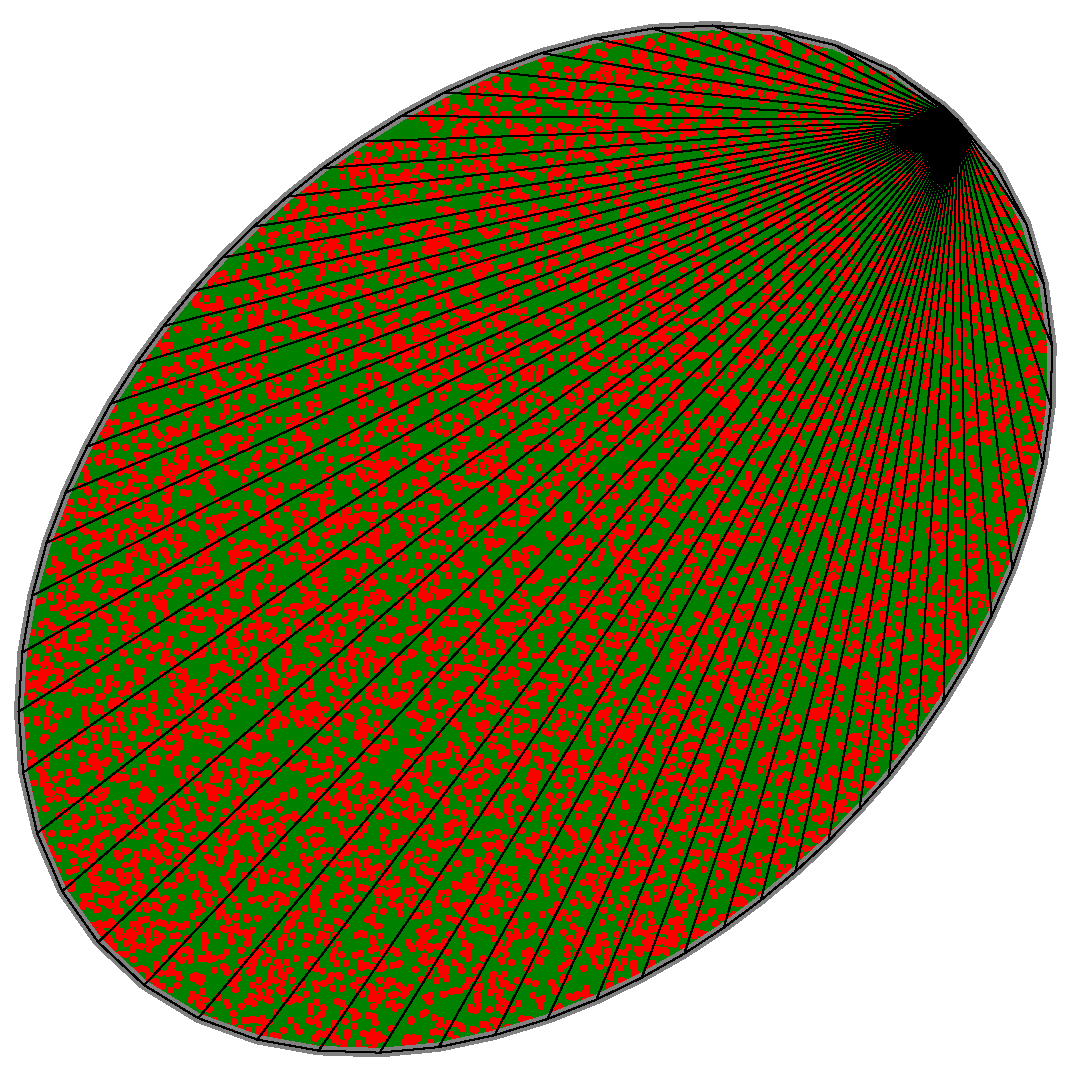


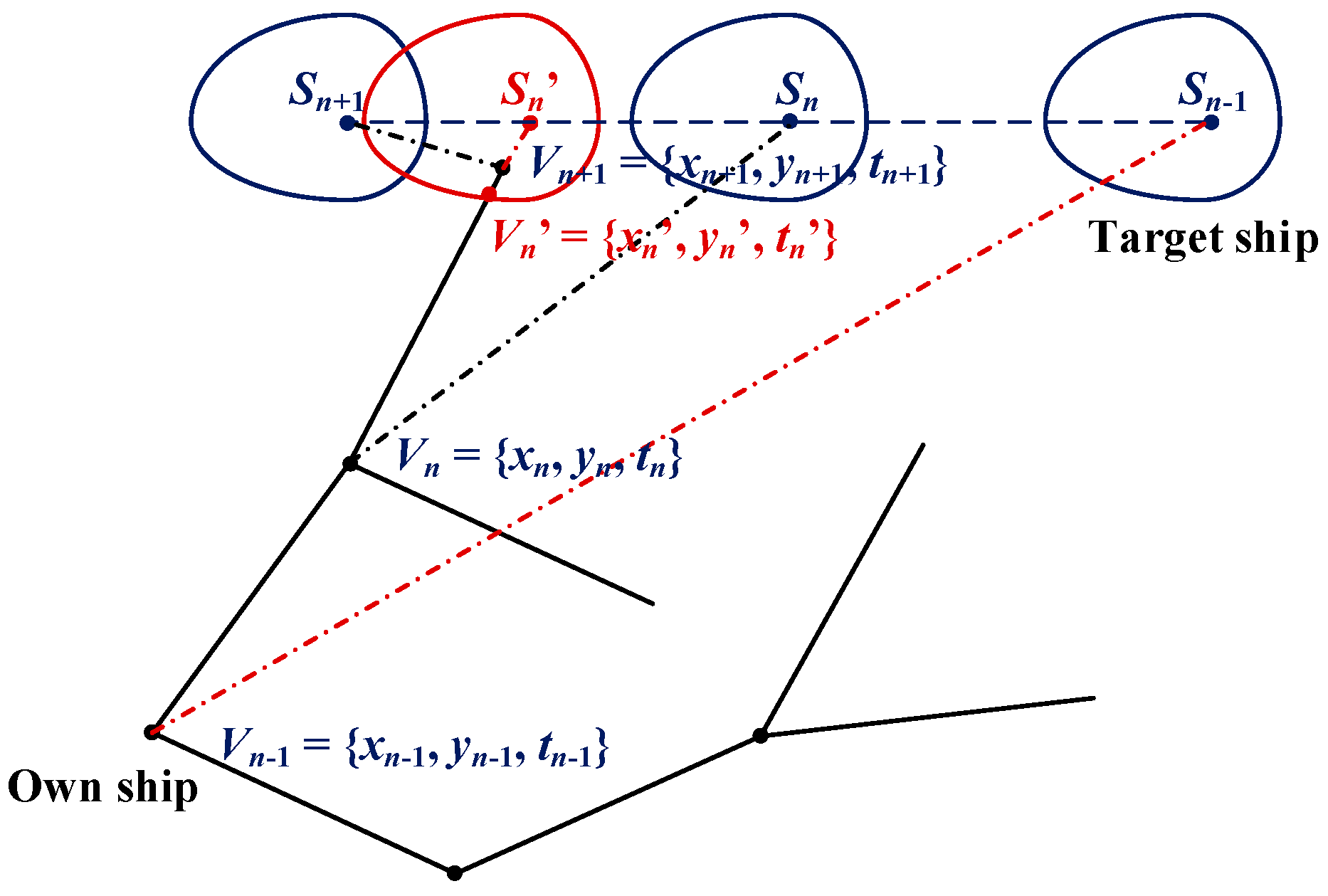
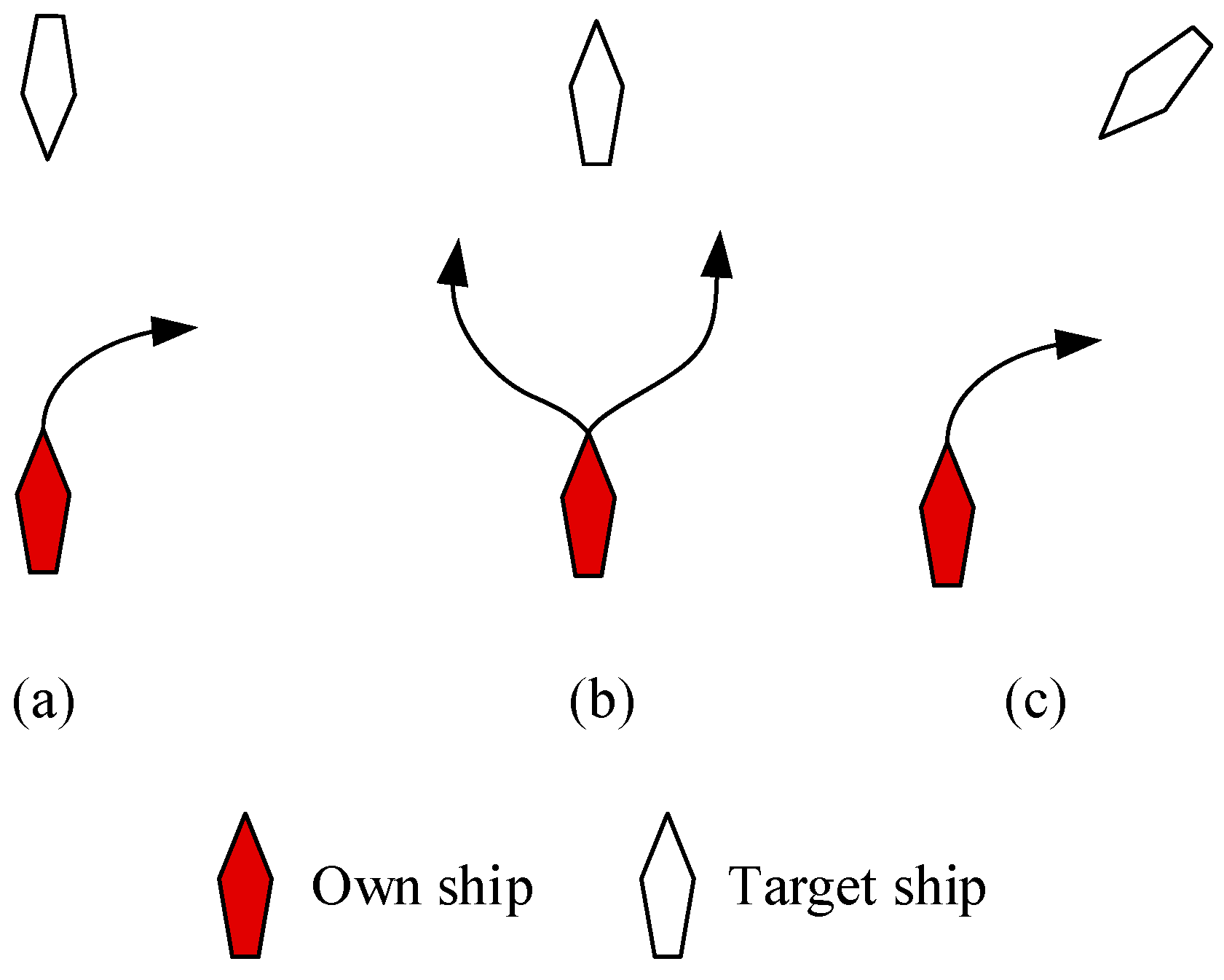



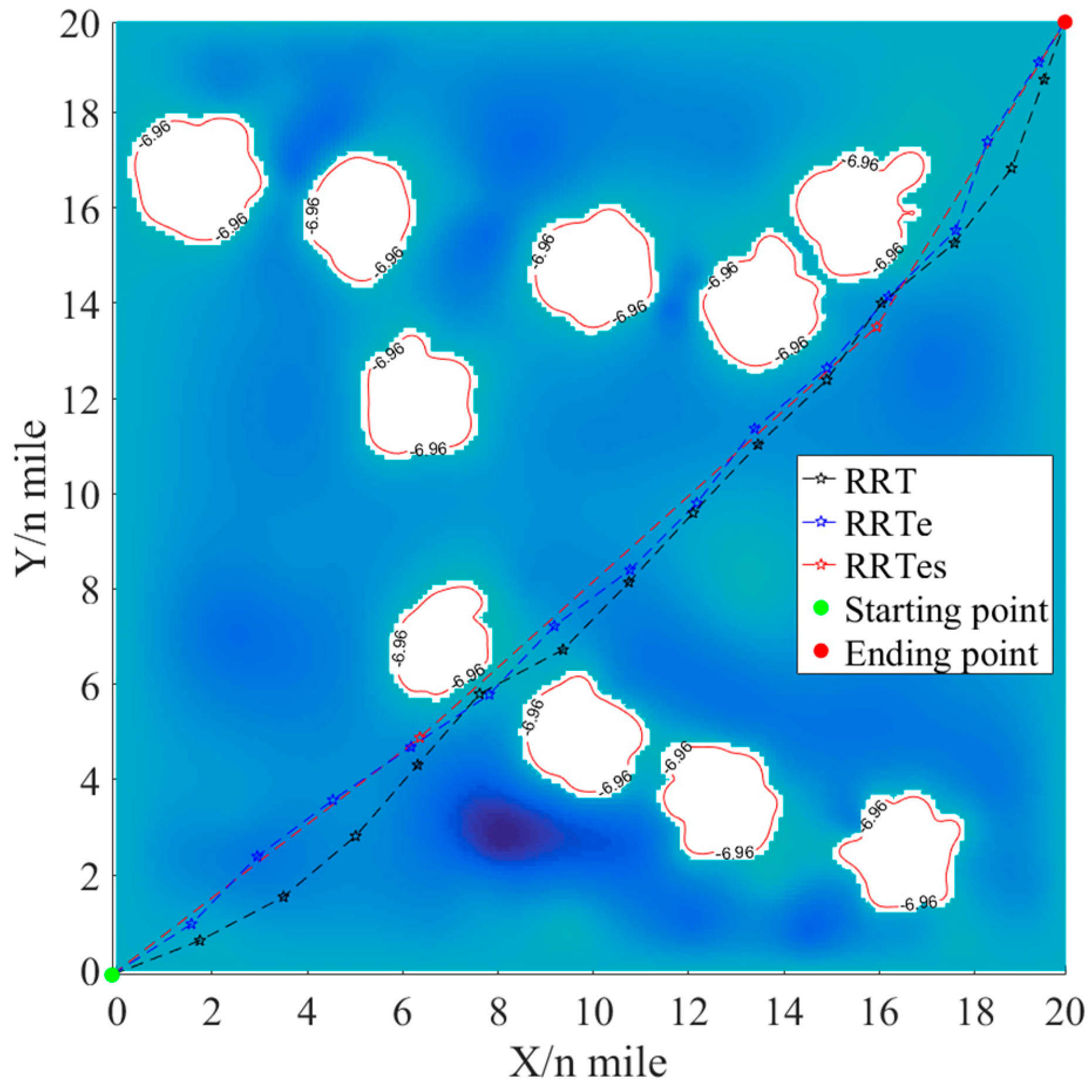


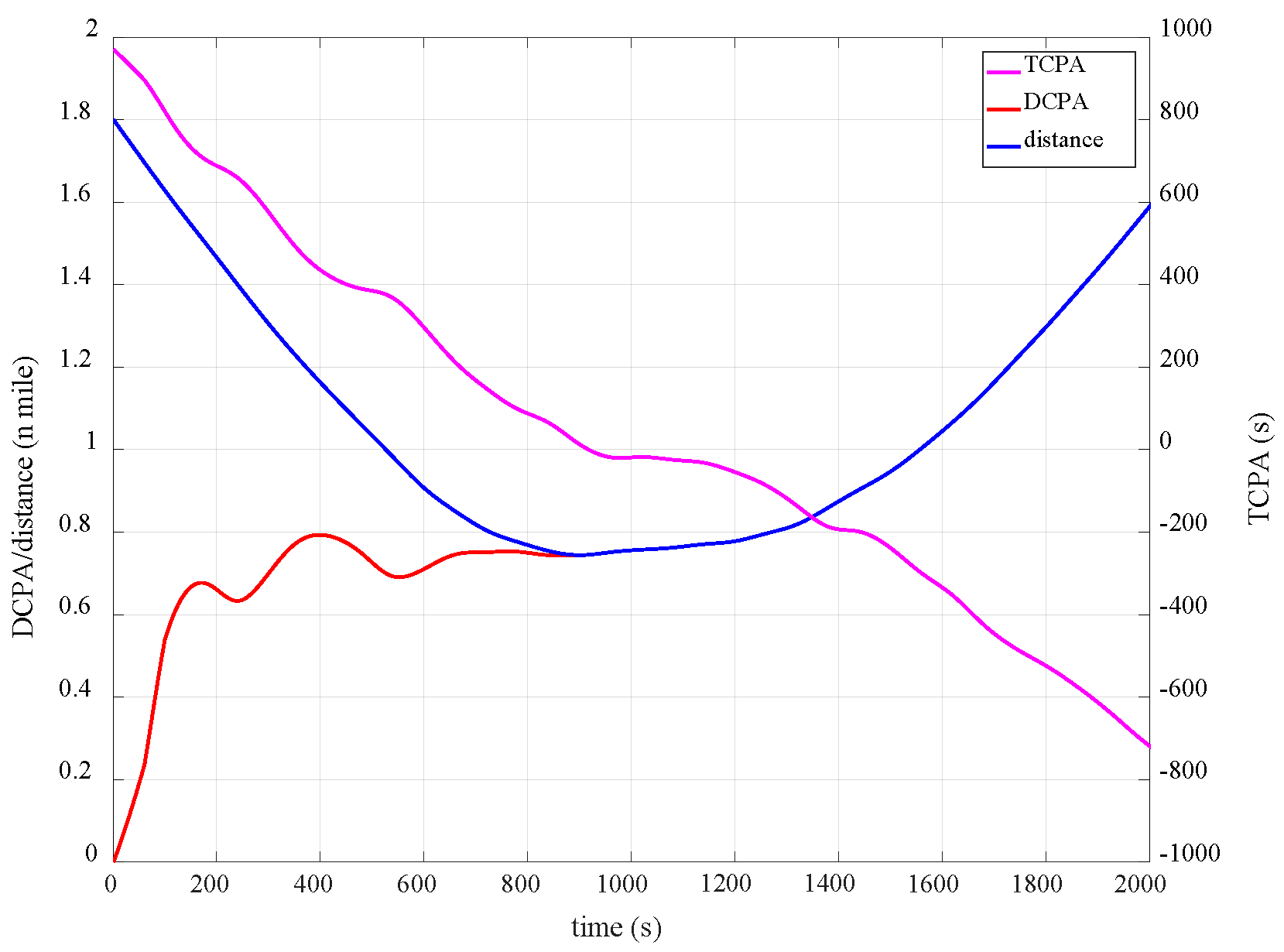
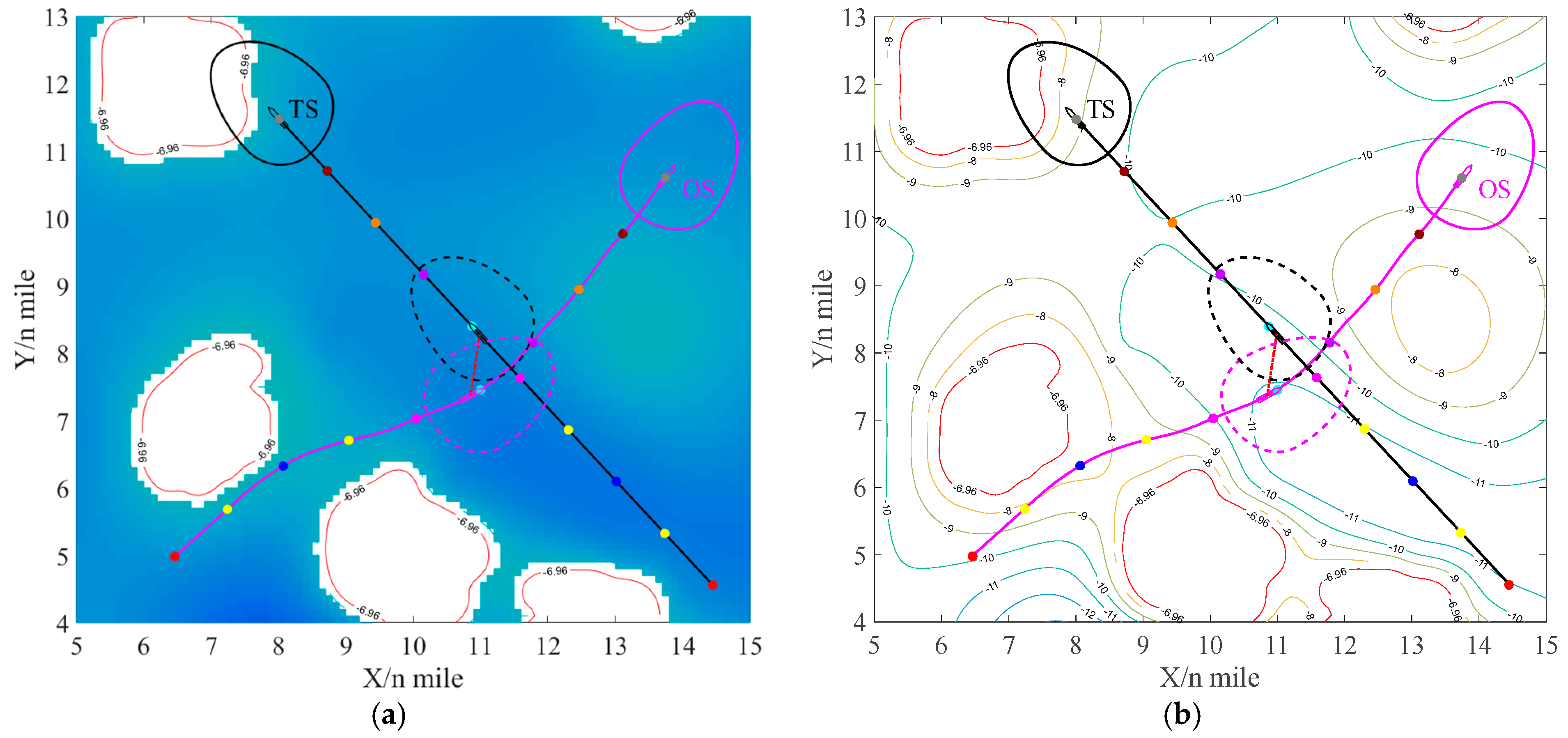
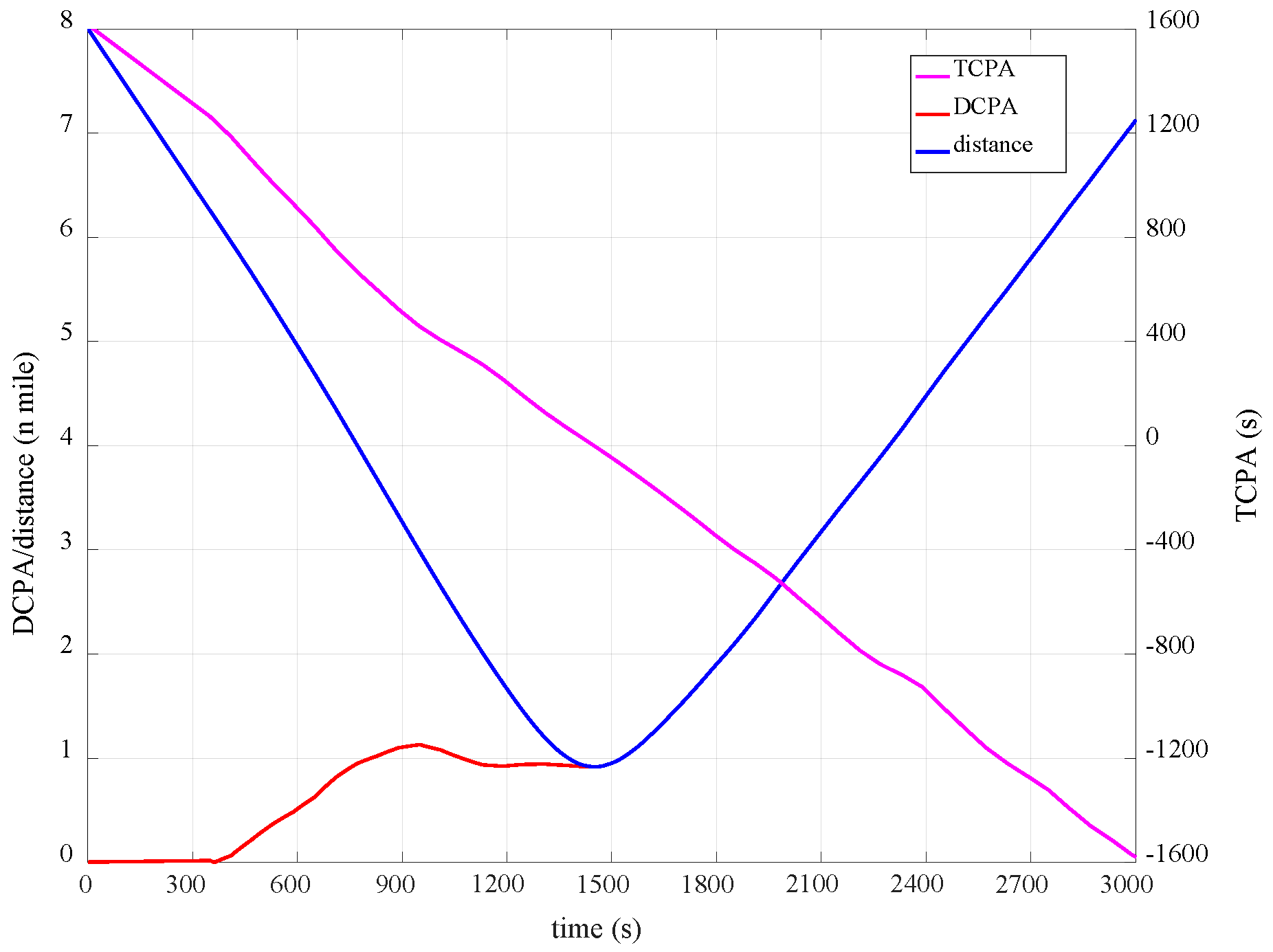
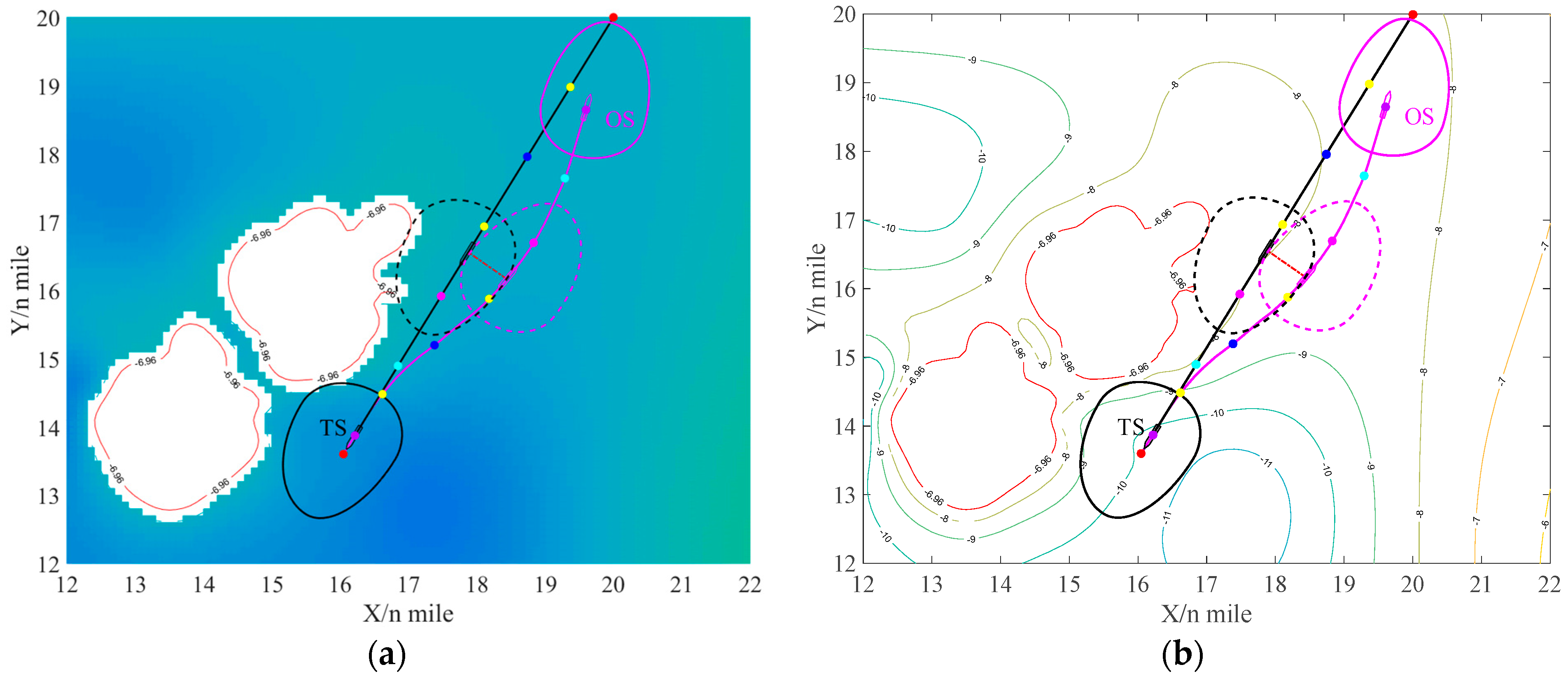
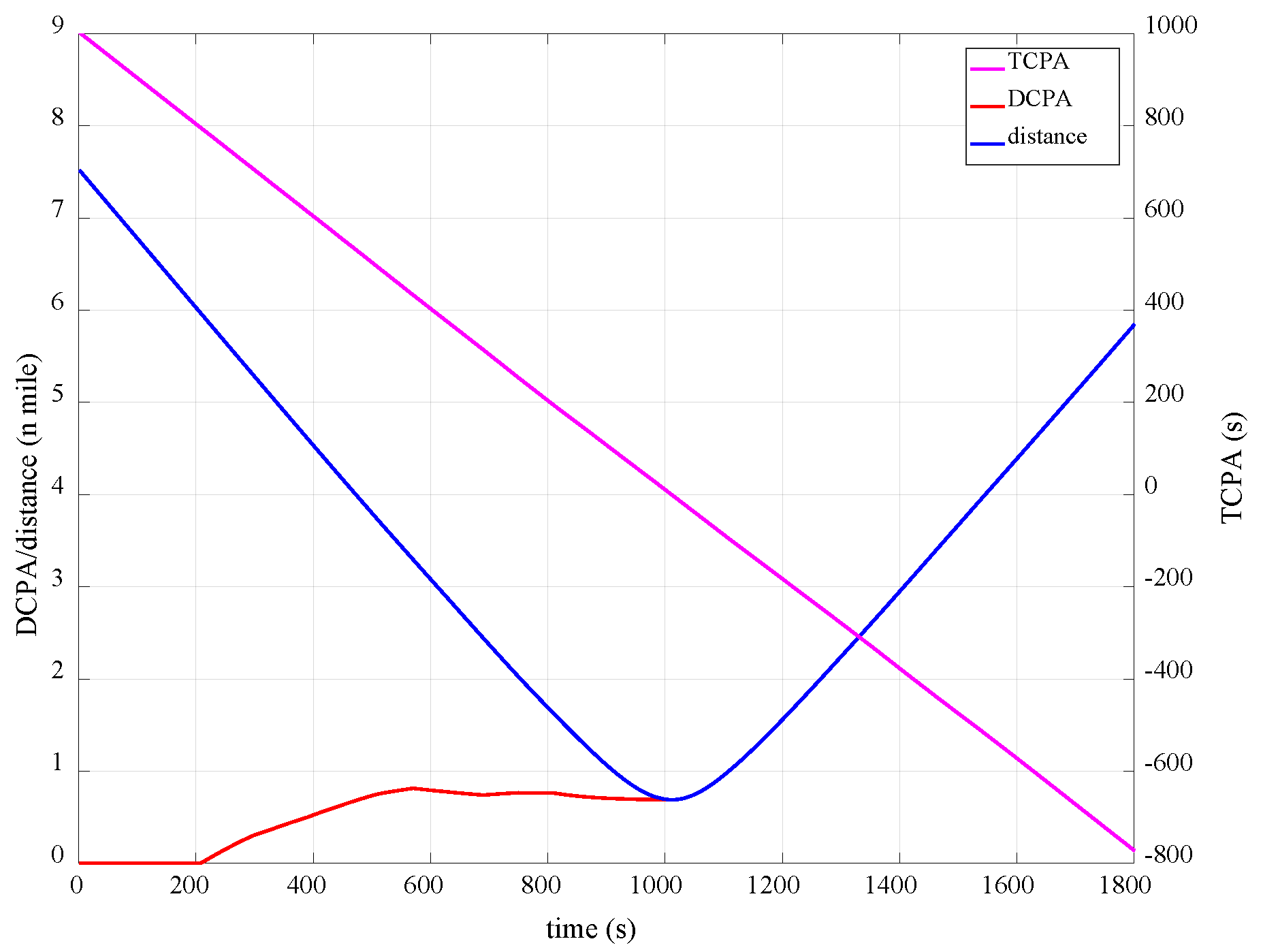

| No. | Nodes Position/n miles | |||||
|---|---|---|---|---|---|---|
| RRT | RRTe | RRTes | ||||
| 1 | 0.00 | 0.00 | 0.00 | 0.00 | 0.00 | 0.00 |
| 2 | 1.84 | 0.72 | 1.67 | 1.07 | 6.46 | 4.98 |
| 3 | 3.60 | 1.64 | 3.05 | 2.49 | 16.05 | 13.60 |
| 4 | 5.11 | 2.91 | 4.63 | 3.67 | 20.00 | 20.00 |
| 5 | 6.41 | 4.41 | 6.27 | 4.78 | The shortest path length: RRT: 29.01 n miles; RRTe: 28.73 n miles; RRTes: 28.57 n miles. | |
| 6 | 7.71 | 5.90 | 7.92 | 5.89 | ||
| 7 | 9.47 | 6.83 | 9.28 | 7.32 | ||
| 8 | 10.85 | 8.24 | 10.87 | 8.50 | ||
| 9 | 12.19 | 9.69 | 12.27 | 9.90 | ||
| 10 | 13.56 | 11.13 | 13.49 | 11.47 | ||
| 11 | 15.00 | 12.49 | 15.00 | 12.74 | ||
| 12 | 16.15 | 14.10 | 16.30 | 14.24 | ||
| 13 | 17.68 | 15.36 | 17.70 | 15.63 | ||
| 14 | 18.88 | 16.93 | 18.37 | 17.49 | ||
| 15 | 19.56 | 18.79 | 19.45 | 19.15 | ||
| 16 | 20.00 | 20.00 | 20.00 | 20.00 | ||
| Own Ship (OS) | Target ship (TSs) | Distance /n Miles | Situation | ||||
|---|---|---|---|---|---|---|---|
| Position/n Miles | Heading/◦ | Speed/kn | Position/n Miles | Heading/◦ | Speed/kn | ||
| (0.0, 0.0) | 52.4 | 12.6 | (1.43, 1.10) | 52.4 | 6.3 | 1.80 | Overtaking |
| (6.46, 4.98) | 48.0 | (14.45, 4.56) | 318.0 | 12.6 | 8.00 | Crossing | |
| (16.05, 13.60) | 31.7 | (20.0, 20.0) | 211.7 | 14.4 | 7.52 | Head-on | |
| Time/s | Global Path Planning | Local Path Planning | ||
|---|---|---|---|---|
| Overtaking | Crossing | Head-On | ||
| Average | 77.73 | 37.48 | 43.18 | 34.24 |
| Maximum | 162.73 | 50.61 | 57.53 | 54.81 |
| Minimum | 36.73 | 27.90 | 31.25 | 14.88 |
Publisher’s Note: MDPI stays neutral with regard to jurisdictional claims in published maps and institutional affiliations. |
© 2022 by the authors. Licensee MDPI, Basel, Switzerland. This article is an open access article distributed under the terms and conditions of the Creative Commons Attribution (CC BY) license (https://creativecommons.org/licenses/by/4.0/).
Share and Cite
Zhang, J.; Zhang, H.; Liu, J.; Wu, D.; Soares, C.G. A Two-Stage Path Planning Algorithm Based on Rapid-Exploring Random Tree for Ships Navigating in Multi-Obstacle Water Areas Considering COLREGs. J. Mar. Sci. Eng. 2022, 10, 1441. https://doi.org/10.3390/jmse10101441
Zhang J, Zhang H, Liu J, Wu D, Soares CG. A Two-Stage Path Planning Algorithm Based on Rapid-Exploring Random Tree for Ships Navigating in Multi-Obstacle Water Areas Considering COLREGs. Journal of Marine Science and Engineering. 2022; 10(10):1441. https://doi.org/10.3390/jmse10101441
Chicago/Turabian StyleZhang, Jinfen, Han Zhang, Jiongjiong Liu, Da Wu, and C. Guedes Soares. 2022. "A Two-Stage Path Planning Algorithm Based on Rapid-Exploring Random Tree for Ships Navigating in Multi-Obstacle Water Areas Considering COLREGs" Journal of Marine Science and Engineering 10, no. 10: 1441. https://doi.org/10.3390/jmse10101441





